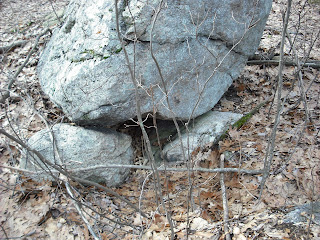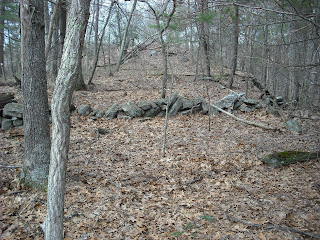The high water hides most of the turtle's head, but makes it easier to see the top of the flat rock.
A large cavity is worn into the top of the flat rock.
Two smaller, more shallow depressions are seen to the right of the larger cavity on the upper surface of this rock. In the center side of the rock is a "gutter". For countless years this rock stood on dry land and Native women ground acorns in the hollows and soaked out the tannins in the pond water. Environmental change and damming of the Quequechan River have raised the water level by about two feet. This created a beautiful marsh containing invasive purple loosestrife and other species unknown to the Natives. Anyone interested in the environmental changes occurring in New England after first contact should read "Changes in the Land" by William Cronon.
Further south from the turtle effigy is this stone row, first shown 6/13/2012.
This heron is enjoying the serenity of the spot. On the east shore, most of this stone row at the small enclosure (7/4/2012) is hidden.
However, the rock propped between two larger ones is still visible.
The hill in the distance is in Fall River. Rolling Rock stands at its crest, and was probably faintly visible from most of the stone row sites on the pond. The ground within these stone row sites is sandy and free of large rocks, suggesting they were Native summer encampments. Sometimes when I am out kayaking and see families enjoying a beautiful summer afternoon at their camps and cottages, I imagine Natives hundreds of years ago also enjoying the pond.
Here is the large rock at the east shore site, and a looming dark cloud.
Time to head back to the put-in!








































